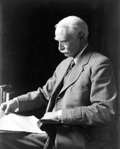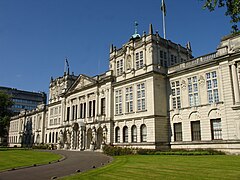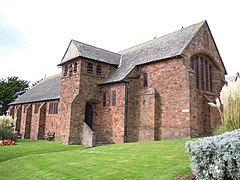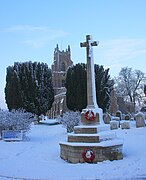
Sir George Gilbert Scott, largely known as Sir Gilbert Scott, was a prolific English Gothic Revival architect, chiefly associated with the design, building and renovation of churches and cathedrals, although he started his career as a leading designer of workhouses. Over 800 buildings were designed or altered by him.
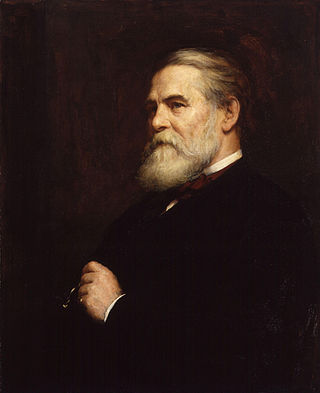
John Loughborough Pearson was a British Gothic Revival architect renowned for his work on churches and cathedrals. Pearson revived and practised largely the art of vaulting, and acquired in it a proficiency unrivalled in his generation. He worked on at least 210 ecclesiastical buildings in England alone in a career spanning 54 years.
The year 1885 in architecture involved some significant architectural events and new buildings.
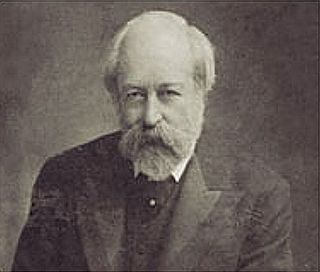
George Frederick Bodley was an English Gothic Revival architect. He was a pupil of Sir George Gilbert Scott, and worked in partnership with Thomas Garner for much of his career. He was one of the founders of Watts & Co.
Thomas Rickman was an English architect and architectural antiquary who was a major figure in the Gothic Revival. He is particularly remembered for his Attempt to Discriminate the Styles of English Architecture (1817), which established the basic chronological classification and terminology that are still in widespread use for the different styles of English medieval ecclesiastical architecture.

Sir Arthur William Blomfield was an English architect. He became president of the Architectural Association in 1861; a Fellow of the Royal Institute of British Architects in 1867 and vice-president of the RIBA in 1886. He was educated at Trinity College, Cambridge, where he studied Architecture.

Charles Donagh Maginnis was an Irish-American architect. He emigrated to Boston at age 18, trained as an architect and went on to form the firm Maginnis & Walsh, designing ecclesiastical and campus buildings across America. From 1937 to 1939, Maginnis held the office of President of the American Institute of Architects.

Edward Blore was a 19th-century English landscape and architectural artist, architect and antiquary.

Romanesque Revival is a style of building employed beginning in the mid-19th century inspired by the 11th- and 12th-century Romanesque architecture. Unlike the historic Romanesque style, Romanesque Revival buildings tended to feature more simplified arches and windows than their historic counterparts.
Robert William Billings was a British architect and author. He trained as a topographical draughtsman, wrote and illustrated many books early in his career, before concentrating on his architectural practice.

Ewan Christian (1814–1895) was a British architect. He is most frequently noted for the restorations of Southwell Minster and Carlisle Cathedral, and the design of the National Portrait Gallery. He was Architect to the Ecclesiastical Commissioners from 1851 to 1895. Christian was elected A RIBA in 1840, FRIBA in 1850, RIBA President 1884–1886 and was awarded the Royal Gold Medal in 1887.

Treberfydd House is a Gothic Revival house, built in 1847–50 just south of Llangorse Lake in the Brecon Beacons National Park in South Wales, to the designs of architect John Loughborough Pearson. It remains a private home to the Raikes family and is a Grade I listed building. The gardens are listed on the Cadw/ICOMOS Register of Parks and Gardens of Special Historic Interest in Wales.
Sir Olaf Kirkpatrick Kruuse Caroe, was an administrator in British India, working for the Indian Civil Service and the Indian Political Service. He served as the Foreign Secretary to the Government of India during the World War II and later as the Governor of the North-West Frontier Province. As Foreign Secretary, he was responsible for reviving the McMahon Line, which included the Assam Himalayan frontier within India. After retirement, Caroe took on the role of a strategist of the Great Game and the Cold War on the southern periphery of the Soviet Union. His ideas are believed to have been highly influential in shaping the post-War policies of Britain and the United States. Scholar Peter Brobst calls him the "quintessential master of the Great Game" and the "foremost strategic thinker of British India" in the years before independence.

Martin Bragg Caroe FSA was an English conservation architect, and partner in Caroe & Partners from 1963 until his death.
Alban Douglas Rendall Caroe OBE FSA FRIBA was a British architect.

Nathaniel Hitch (1845–1938) was a British sculptor. As a young man, he became an apprentice sculptor journeyman and after studying at the Borough Polytechnic and experience working alongside architectural sculptors, he developed a career carving altarpieces, church furniture and other decorative features for churches.
David Wyn Roberts was a British architect and educator, who designed more university buildings for Cambridge University than any other architect. With a modernist practice based in Cambridge, he also designed many city housing projects, schools, and private residences.

Charles Arthur Ford Whitcombe (1872-1930) A.R.I.B.A. was a British architect, best known for his ecclesiastical designs. He was from Tibberton, Worcestershire and had his London office at 5 Newman Street, Oxford Street. In 1916 he emigrated to Queensland, Australia to become 'Chief Instructor - Architecture' at the Central Technical College, Brisbane.

Howard Douglas Horsfall was a stockbroker and benefactor based in Liverpool, England. He is remembered for building churches in Liverpool, and as a founding benefactor of St Chad's College, Durham.
